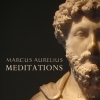
How difficult can it be to become a Stoic? Well, the answer depends on your mindset towards this journey. A lot of people think it is too challenging and ultimately give up. Those people are partly right – it is challenging. Reaching philosophical enlightenment isn’t meant to be easy, but the prize at the end is so very worth the effort. We will discuss some of the most challenging Stoic practices, but also offer the many benefits to practicing these things.
Meditating
We are living in an era where information is instantaneous and technology is prevalent in every part of our lives. Although this provides us with countless benefits, it also shows a disturbing tendency: people don’t know how to deal with idleness.
Idleness is having absolutely nothing to do. This isn’t necessarily a bad thing, but many people feel the need to fill this idleness with activity. But idleness can be highly beneficial if we use this time to keep company with yourself. It is a chance for you to reflect upon your emotions and fears and goals. It is a moment that exists to let you acknowledge yourself and to analyze it.
Idleness is essential for a considered mind, but people keep looking for ways to fill these moments. Not knowing how to accept idleness can make it very difficult for people to meditate. We are not talking about sitting cross-legged and facing a blank wall; meditation has nothing to do with that. It is an exercise of silencing the external world, calming your mind, and getting to know yourself better.
Perhaps you have tried to meditate before. You have found the time for it and accepted that idleness. Maybe you have managed to silence the external world around you, but at the last moment your thoughts would start spinning and disrupting your ability for reflective thought.
If you struggle with that, then there are tools to help you. You can practice a mantra to silence your mind. Focus on repeating your mantra, whatever it may be, over and over until your mind calms down enough to meditate without becoming distracted. After doing this exercise a couple times, you will be able to establish a stable communication with your mind in order to ask and answer questions without interruption.
Keeping a Journal
Once we have developed the meditation skill and established a reasonable communication with our mind, it is time to note down a few thoughts regarding these internal conversations. What have you learned about yourself? What do you still need to improve? Build a collection of reminders that will help you in future meditations and throughout your everyday life.
Some of these notes may be difficult to apply to daily life. In this case, you can write them down on sticky notes and put them in places you will see them often (e.g. on your fridge, on your pinboard, on your bathroom mirror). The note will remind you to stop, take a deep breath, and restart the work of implementing them into your life.
When is the best time to write in your journal? Straight after your meditation. Write down the results of your meditation while those thoughts are still fresh in your mind. Sometime later, on the following day perhaps, you can re-read those notes, without criticism or judgement, and evaluate if you are on the right path to what you are looking for.
You can even have multiple journals: one for home, a little one when you’re out and about, one on your phone just in case you forget your journal. It is not about the journal itself; it doesn’t have to be the prettiest or neatest-kept thing. It is about the notes. Those notes are not for anyone but yourself, so focus on the message behind them and not how they look.
Memento Mori
The most uncomfortable Stoic exercise is thinking about death. The Latin phrase memento mori (remember you must die) is the perfect example of this. This is one such topic you should certainly meditate on. Put aside some time and think about your life and the certainty of death. Are you ready to leave this world? If you were to die tomorrow, would you be happy with your life?
In this exercise, you are not meant to think about how or when your death is going to happen – it’s not about that. Your death is out of your control, so you shouldn’t waste time worrying about it. Instead, meditate on the unfinished business you do have control over.
Is there something you have been putting off or avoiding? Are you holding onto any unnecessary resentment? Consider the legacy you are leaving behind and the contributions you have made for humankind and our planet. If you think you can do more, work on it as soon as possible. By meditating on death, you will be ready to face death when the time comes without any regrets.
Negative Visualization
Negative visualization is a Stoic practice that involves imagining your life without all the belongings and comforts you currently take for granted. The goal here is gratitude. Think about the things and people that matter to you, and then picture your life without them. You will come to see how many things you should be grateful for, and what you may be able to improve in your relationships.
By practicing negative visualization and implementing gratitude into your life, you will wake up each day and be thankful for one more day and everything it will bring. You will learn to be grateful for everything you have that makes your life comfortable and fulfilled. You will be thankful even for the difficulties, because you will understand that any hardship is not intended to make you suffer, but to make you a better person.
Control
Finally, the most important and constant exercise of Stoicism. Stoics believed in what they called the Dichotomy of Control – understanding what is in your control and what is not in your control. They believed that our mind and will is in our control and all other things are outside our control.
We can implement this idea in practice. For each situation that you experience, you must question: Is it something I can control? If it is external to our mind and will, then the answer is no. So, why worry about it? You can’t change it, so just accept it. But if the answer is yes, then implement your control over that situation and make the most of it.
The things we can control are intimately related to ourselves. We can control our emotions, our feelings, thoughts and actions. Most of all, we can control how we react to the external world.
You might be thinking that I make it sound so easy, when in reality it sounds very difficult to implement. You’d be right, but the trick is practice and not giving up. You might lose track of your control today, but will grasp it better tomorrow. Every tomorrow is a chance to try again.
The Stoic philosopher Epictetus taught us that we should establish small milestones and celebrate each one of them. So, establish small goals and work hard on them and congratulate yourself each time you make progress. You will be thrilled at what you are capable of, so long as you don’t give up.










